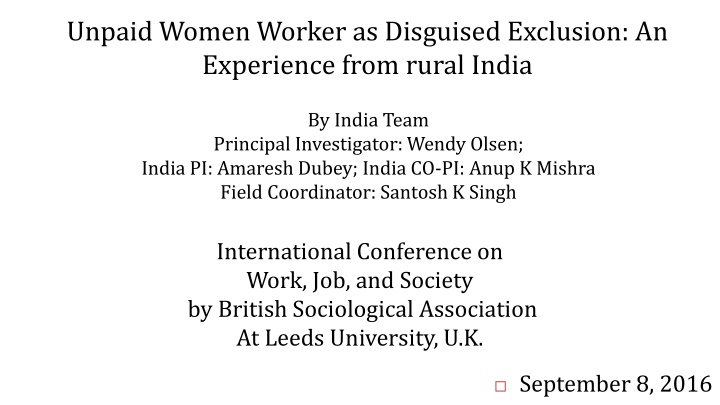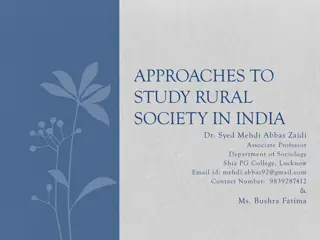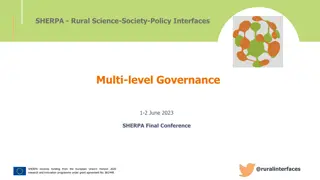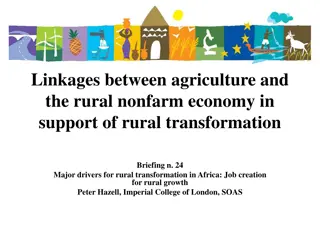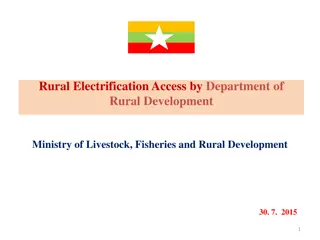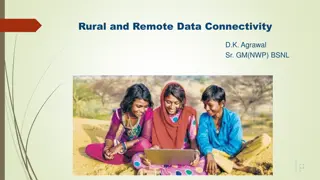Challenges of Female Workforce Participation in Rural India
Despite high economic growth, female labor force participation remains low in India. This study explores the hidden contributions of unpaid women workers in rural areas and the need to address this disguised exclusion to truly empower women in the economy.
Download Presentation

Please find below an Image/Link to download the presentation.
The content on the website is provided AS IS for your information and personal use only. It may not be sold, licensed, or shared on other websites without obtaining consent from the author.If you encounter any issues during the download, it is possible that the publisher has removed the file from their server.
You are allowed to download the files provided on this website for personal or commercial use, subject to the condition that they are used lawfully. All files are the property of their respective owners.
The content on the website is provided AS IS for your information and personal use only. It may not be sold, licensed, or shared on other websites without obtaining consent from the author.
E N D
Presentation Transcript
Unpaid Women Worker as Disguised Exclusion: An Experience from rural India By India Team Principal Investigator: Wendy Olsen; India PI: Amaresh Dubey; India CO-PI: Anup K Mishra Field Coordinator: Santosh K Singh International Conference on Work, Job, and Society by British Sociological Association At Leeds University, U.K. September 8, 2016
This presentation India part of the work: secondary data analysis and field survey Activity status and definition of labour supply Trends in female labour supply Contextualizing the Indian perspective: socio-religious and cultural context Unpaid Women Worker Quantifying the Women s Unpaid Work Concluding observations
Introduction In spite of high economic growth during last decades there has been low rate of female labour force participation (FLP) in India. This has been the recent issue that have to be looked upon thoroughly. More than in any other area, it is in the recording of the work done by women that serious inaccuracies and measurement failure occur. As a result, their participation in the economy in undermined. The experience from other countries suggest that the combined effect of economic growth, rising educational level among women and falling fertility rates leads to increasing participation of women in the labour force.
Introduction (continued..) Census after Census, women's contribution has been rendered invisible by failing to quantify their work inputs, especially in agriculture and the unorganized sector. Women are known to work longer hours than men and to participate in the work force to a far greater extent than is measured by the data gathered in the census. But a lot of the work they do is unrecognized, leave alone rewarded with equal remuneration. Traditionally, men spend most of their time on tasks for which payment is received or tasks that are clearly within the realm of "economic activity" ( Mehta, 2000) .
Introduction (continued) However, while a large number of women work outside the home and are remunerated for the work they do, most women spend several hours doing work for which no payment is received. This seems as a disguised exclusion of rural household women from the mainstream of economy. The effort of the present paper is to only investigate and share our field experiences of this fact from Rural North India.
Under this backdrop India s rate of economic growth has averaged over 6 per cent since 1991, female literacy rates have increased from 53.7 per cent in 2001 to 64.5 per cent in 2011. In spite of this, female workforce participation rates fell from 33.1 per cent in 1977-78 to 26.1 per cent in 2009- 10 for rural females and from 15.6 per cent in 1977-78 to 13.8 per cent in 2009-2010 (using employment in principal and subsidiary status, see Himanshu (2011).
Objective and Methodology of the Study The main aim of this paper is to investigate women s unpaid household work in the rural India and attempts to assess an economic value for it. The specific objectives of this paper are to obtain primary data of socio-economic status of the rural household, analyze the average daily time spent on unpaid work and to access and assign an approximate economic value to the unpaid work. The research carried time use survey in three states of North India i.e Uttar Pradesh, Bihar and Jharkhand of rural areas. The sample consisted of around 500 rural men and women in each category. Fifteen villages have been chosen for the study.
Socio-religious and cultural context: India Indian population structure Hindu Verna system--- hierarchical social structure along caste lines, influenced occupational outcomes Religious influences: indigenous and outside Socio-religious categories Does it have any influence on labour supply??
Population Structure: Social Group and Religion Social Group Population Share ST 8.7 Religion Population Share SC 18.8 Hindu 81.4 OBC 44.0 Muslims 13.8 OTH 28.4 Christians 2.1 All 100.0 ORM 2.7 All 100.0
Population structure: Social group x Religion ST SC OBC OTH All R/S 86.6 93.9 81.9 70.7 81.4 Hindu ST SC OBC OTH All R/S Muslims 1.8 0.2 16.0 23.3 13.8 9.2 21.8 44.3 24.7 100 Hindu Christians 8.7 0.2 1.4 2.3 2.1 Muslims 1.1 0.3 50.8 47.8 100 2.9 5.7 0.8 3.8 2.7 ORM Christians 36.6 2.0 29.9 31.5 100 100 100 100 100 100 All 9.1 39.0 12.7 39.3 100 ORM 8.7 18.8 44.0 28.4 100 All
The Categorisation of Labour Force Participation Table 1 shows female labour participation in rural India according to various definitions (defined by Dubey, Olsen & Sen 2016). Table 1: Rural India, Female Labour Force Participation, Competing Definitions Column Percentage of Workers, 1983 Column Percentage of Workers, 2011/2012 It shows that, except as per wide def n of LFP3 the female labour force participation in every category has been decline over time (since 1983). 1993- 94 2004- 05 2011- 12 % of Women 1983 Salaried Work and Employees Only That + Casual Labour (Narrow Def n, LFP1) That plus those Unemployed 1.50% 1.4 2 2.2 0.7 1.3 Only as per wide def n that plus extra-domestic duties of women the female labour increased since 1983 that is 33.5 per cent to 39.3 per cent in the year 2011/12. This is the concern of our present paper. force participation has 23.5 24 22.2 17.5 11.5 10.6 24 24.5 23.3 18.2 11.7 11 That plus those Self-Employed (Medium Def n, LFP2) 35.4 32.7 31.5 24.7 17.2 15 In our present paper we tried to examine the economic role of this wide def n female worker which could be valued according to labour market. That plus those who worked as helper in household enterprise 52.1 51.3 52.7 37.5 25.4 22.7 That plus extra-domestic duties (EDD) (Wide Def n, LFP3) For this purpose we apply the time use data. This data have been collected around the clock (of the previous working day) for both male and female respondents in the study area. 68.8 71.2 70.7 64.8 33.5 39.3 Total For Narrow, medium and wide definition of labour see, Dubey, Amaresh; Olsen, Wendy and Sen, Kunal (2016), 'The Decline in the Labour Force Participation of Rural Women in India: Taking a Long-Run View' 100 100
Labour supply: female, male (different definitions) Definitions used are LFP1 (narrow, casual and salaried employment), LFP3 (includes self- employing proprietors), and LFP6 at top (includes all remunerated work) Dubey et al 2015 100.0 91.0 90.0 89.8 88.7 83.7 80.0 LFP1-Male 71.2 70.7 70.0 68.8 64.8 60.0 LFP1- Female LFP3-Male 50.0 40.0 30.0 LFP3- Female 20.0 10.0 0.0 1983 1994 2005 2012
Decline in labour supply: social group Definitions used are LFP1 (narrow, casual and salaried employment), LFP3 (includes self- employing proprietors), and LFP6 at top (includes all remunerated work) (Dubey et al 2015) 100.0 90.0 80.0 LFP1-ST LFP1-SC 70.0 LFP1-Others 60.0 LFP3-ST 50.0 LFP3-SC 40.0 LFP3-Others LFP6-ST 30.0 LFP6-SC 20.0 LFP6-Others 10.0 0.0 1983 1994 2005 2012
Female labour participation: by marital status of women (LFP definition LFP3, (Dubey et al 2015) ) 60.0 50.0 Never Married 40.0 Currently Married 30.0 Widowed 20.0 Divorced/Separa ted 10.0 0.0 1 2 3 4
LFP and Education: More drop in LFP 90.0 90.0 80.0 80.0 70.0 70.0 60.0 Illiterate 60.0 1983 50.0 Upto Primary 50.0 1994 40.0 Middle 40.0 2005 30.0 Sec or High. Sec 30.0 2012 20.0 Grad. or above 20.0 10.0 10.0 0.0 Illiterate Upto Primary Middle Sec or High. Sec Grad. or above 0.0 1983 1994 2005 2012 An unchanged U-curve by education, but strong drop off for secondary and degree holders, using LFP6 (wide definition including all remunerated work) (Dubey et al 2015)
LFP and Education: More drop in LFP (2) 45.0 For LFP3, the drop for degree holders is large. 40.0 35.0 30.0 Illiterate Upto Primary 25.0 Illiterate women of high age also withdrew. Middle 20.0 Sec or High. Sec 15.0 Grad. or above 10.0 5.0 (Dubey et al 2015) 0.0 1983 1994 2005 2012
Background of the Study A large literature has examined recent trends in rural female labour force participation (RLFPR) in India. There seems to be no consensus, however, on what explains the recent decline in RLFPR.
On Gender Inequality Gender equality is elemental for sustainable economic growth and poverty reduction. Equitable approach to jobs in rural areas enable rural women to become active economic performer of growth as money earner; despite of doing unpaid household work as well. Gender inequalities especially in rural employment subsist far and wide, indifferent to the level of economic development in the country despite of different precedents of social, cultural, religious and economic dynamics. Some of them such as the burden of unpaid work at home, lack of education and dealing authority, and limited right of property - undoubtedly compose large gender disparity. On economic arena, gender bias in India is perceptible especially in the form of rural wages.
The following data in this respect are self explanatory Gender gaps in rural wages in India Women s wage as % of Men s Sector Type of employment Agriculture Agriculture Daily Casual wage 69 Daily Regular wage 79 Non-Agriculture Daily Casual wage 65 Non-Agriculture Daily Regular wage 57
The Present Study The study conducted in the 15 villages of the north rural India in the year 2015 confirms the unequal unpaid work status between men and women. We observed that women are far more involved in unpaid economic activities (domestic activities) than men. Applying the time use method on the basis of time use survey we found that on an average, women spent 8-9 hour (8.73 hours) daily on categorized unpaid economic activity and on other side men spent only 2-3 hours (2.88 hours) for the same.
Population distribution in various usual principal occupation Male Female Nearly 76 percent female are engaged as unpaid women worker (as household work and family worker) which indicates the double burden on rural female in the study areas. Occupation of Usual principal activity Professionals Self-employed (with employees) FC OBC SC ST TOTAL 0.86 FC OBC SC ST TOTAL 1.36 1 0.51 0.1 2.04 39.1 1.5 32.2 0.43 20.4 1.37 0.19 0.1 Employed workers 2 3 3 25.64 31.42 1.54 2.45 3.59 2.63 2.45 26.5 23.9 10.4 Own account workers 3 2 3 15.38 21.63 0.77 3.58 1.54 7.89 2.64 40.8 Only 7 percent female are engaged in proper wage economic activities. Manual Labourers Family worker Unemployed 4.76 0.34 2.04 19.1 1.16 0.83 7 38.46 20.43 0.86 1.55 1.7 1.7 2.56 1.54 1.03 72.8 7.89 2.63 1.66 1.37 0.2 0.87 2.61 0.39 2.56 75.6 76.2 Housewife 1.7 22.1 1.5 18.7 0.87 23.0 2.56 1.46 8 3 2 55.26 74.66 This observation shows that female participation in proper work is very low in comparison of their male counterpart (75.17%) 21.6 14.1 Student 1 7 4 15.38 20.34 2 5 15.9 23.68 16.73 Others TOTAL 0.43 100 0.09 100 0.51 100 0.1 100 100 100 100 100 100 100
Workers population ratio in survey area (15 years and above) UP Bihar Jharkhand Total Caste Male Female Total Male Female Total Male Female Total Male Female Total FC 65.98 3.53 36.81 63.96 1.65 34.04 65.12 2.38 34.12 64.69 2.27 34.83 OBC 74.63 8.86 42.90 64.73 7.60 38.89 75.21 9.90 44.95 71.64 8.67 42.05 SC 71.05 12.77 44.71 60.64 4.71 34.08 76.92 8.33 44.00 68.02 8.84 40.48 ST 68.75 41.67 57.14 64.00 7.41 34.62 100.00 25.00 62.50 68.89 18.60 44.32 Total 72.26 9.47 42.59 63.67 4.73 35.93 73.89 8.20 42.75 69.04 7.36 39.93 There is huge gap between male and female regarding WPR in the study areas. Female WPR is only 7.36 percent against 69.04 percent for male. As per caste wise wpr the lowest female wpr belongs to Forward Caste(2.27%) and highest the ST category (18.6 %). SC s and OBC s wpr is almost equal but more than FC (8.67 & 8.84). The worst condition prevails in the Bihar state where WPR of female is merely 4.73 percent.
Percentage of workers population ratio in survey area (15-59 years) UP Male Female Total Bihar Male Female Total Jharkhand Male Female Total All Male Female Total FC 75.00 4.41 43.42 OBC 80.33 9.86 46.35 SC 75.96 12.50 46.88 ST Total 78.30 10.40 46.30 71.43 41.67 57.69 The table reflects the unequal wpr against female and the worst 71.84 1.96 39.14 72.53 8.61 43.54 65.88 5.63 38.46 78.95 9.09 41.46 71.30 5.54 40.84 condition again prevels in the state of Bihar in north India (5.54 per 77.78 2.78 40.28 83.02 11.11 50.00 76.92 8.33 44.00 100.00 25.00 62.50 81.08 9.04 47.01 cent against 71.3 for male). 73.47 2.72 40.47 78.41 9.71 46.15 72.37 9.23 43.26 78.38 21.05 49.33 75.95 8.28 44.25
Percentage of workers population ratio in survey area (15-59 years) by age group UP Bihar Jharkhand Total As per various age group wpr Age group (5yrs) we found worst condition in Male Female Total Male Female Total Male Female Total Male Female Total the age group of 20-24 (2.14 25.88 3.95 15.53 15.09 2.60 9.84 44.44 2.70 23.29 23.79 3.16 14.39 15-19 per cent) followed by 15-19 62.20 0.00 36.17 62.32 3.45 35.43 71.43 4.35 41.18 63.69 2.14 36.68 (3.16 per cent) and 30-34 20-24 91.03 11.24 48.50 90.77 0.00 46.46 91.30 7.14 45.10 90.96 6.70 47.25 (5.04 per cent). 25-29 97.22 3.57 56.25 89.36 6.67 48.91 96.30 5.56 60.00 94.52 5.04 54.34 The condition of age group 30-34 92.31 16.67 56.00 91.30 8.00 47.92 94.12 17.65 55.88 92.17 13.04 52.61 50-54 (19.7 per cent) is 35-39 97.50 8.57 56.00 100.00 21.05 62.50 100.00 12.50 50.00 98.94 14.61 57.92 highest followed by 55-59 40-44 (14.89 per cent) and of age 96.77 16.67 57.38 97.44 6.67 57.97 88.24 20.00 62.96 95.40 12.86 58.60 45-49 group 40-44 (14.61 per cent) 96.43 28.57 58.73 100.00 5.00 52.50 90.91 18.18 54.55 96.61 19.70 56.00 50-54 100.00 25.00 71.43 100.00 0.00 60.47 100.00 16.67 75.00 100.00 14.89 68.25 55-59 78.30 10.40 46.30 71.30 5.54 40.84 81.08 9.04 47.01 75.95 8.28 44.25 Total
Economic and Non-economic activity Economic activity Crop farming and vegetable gardening Livestock care Fetching of fruits, hunting, collecting Mining and rock quarrying, rock breaking Construction Activities Manufacturing Activities (beedi, garment Trade and Business Services Grinding, flour, husking, or making spic Cleaning Washing and ironing cloths and utensils Repairing the house or repair household Cooking and serving Getting firewood Carrying water, fetching water Childcare Teaching one own children or giving tu Caring for the sick people Training, private or government (DWCRA e Other activities Total Male 1.25 0.93 0.01 0.06 0.88 0.09 0.31 0.74 0.10 0.13 0.02 0.06 0.11 0.04 0.02 0.10 0.18 0.02 0.02 0.85 5.90 Female 0.73 0.67 0.04 0.00 0.01 0.02 0.08 0.05 0.25 0.72 1.37 0.01 3.42 0.14 0.19 0.66 0.08 0.06 0.01 0.78 9.30 We observed that women are for more involved in economic activities (domestic & wage activities) than men. On an average, women spent 9-10 hour (9.30 hours) daily on categorized all economic activity and on other side men spent only 5-6 hours (5.90 hours) for the same.
Economic and Non-economic activity Non-economic activity Work done Sleep and rest Eating and drinking Personal washing, toilet, etc Shopping Travel Participation in meetings of groups, soc Studying Participating in social events: wedding, Socialising, chatting, visiting neighbou Games and hobbies Reading Watching television, video, internet, vi Prayer Male 9.85 1.63 1.49 0.28 1.66 Female 9.4 1.02 1.51 0.02 0.44 0 0.04 0.12 2.18 0.44 0.06 0.17 0.14 0.02 0.05 1.65 0.11 0 0.28 0.2 Total 18.05 14.7
Time use per day in hour of male and female in study area of unpaid economic activity Sex Women are for more involved in Economic Activity Crop farming and vegetable gardening Livestock care Fetching of fruits, hunting, collecting Mining and rock quarrying, rock breaking Construction Activities Manufacturing Activities (beedi, garment Trade and Business Services Grinding, flour, husking, or making spic Cleaning Washing and ironing cloths and utensils Repairing the house or repair household Cooking and serving Getting firewood Carrying water, fetching water Childcare Teaching one own children or giving tu Caring for the sick people Training, private or government (DWCRA e Other activities Total Male 0.78 0.91 0.01 Female 0.43 0.67 0.04 unpaid economic activities 0 - - (domestic activities) than men. 0.01 0.01 0.01 0.03 0.08 0.13 0.02 0.05 0.09 0.01 0.02 0.1 0.11 0.02 0.01 0.48 2.88 0.01 0.02 0.01 0.24 0.71 1.36 0.01 3.4 0.14 0.19 0.66 0.07 0.06 Women spent 8-9 hour (8.73 hours as per table) daily on twenty categorized unpaid economic activity and on other side men spent only 2-3 hours. - 0.7 8.73
Time use per day in hour of male and female in study area of unpaid economic activity . Women spent maximum time in the household for cooking, serving the food, cleaning, washing and related works and caring the children in the house i.e. 5-6 hours on average duty (5.47 hours ) and also they spent 2-3 hours outside household s for the unpaid economic activity like agricultural activity, animal husbandry, collecting and fetching of household uses and manufacturing works etc. (2.46 hours). Females got up early than men. Women s day starts at about 5a.m. and ends after 10 p.m. Rural women are for more involved in a range of domestic activities than men and regularly carrying and approximately 33 tasks in which 20 tasks can be treated as unpaid economic activities. In contrast men carry less household s task and enjoy more leisure than women. Males spent their maximum time (21.12 hours a day) in non-economic activities which includes less use and female spent 15.27 hours as non-economic activities in which very little time is spent on their leisure.
Caste wise Time use per day in hour female in study area of unpaid economic activity As per caste wise economic activities analysis by using time use method (per day in our) we found that forward caste female are spending more time on cooking and serving , washing and ironing cloths and utensils, grinding flour , husking , or making spice and teaching own child in comparison with OBC and SC / ST female in the study area. Activity Crop farming and vegetable gardening Livestock care Fetching of fruits, hunting, collecting Mining and rock quarrying, rock breaking Manufacturing Activities (beedi, garment Trade and Business Services Grinding, flour, husking, or making spic Cleaning Washing and ironing cloths and utensils Repairing the house or repair household Cooking and serving Getting firewood Carrying water, fetching water Childcare Teaching one s own children or giving tu Caring for the sick people Other activities Total FC 0.05 0.16 OBC 0.64 0.81 0.03 SC 0.41 0.81 0.08 ST 0.17 0.9 0.05 0 0 0.05 0.01 0.02 0.01 0.22 0.65 1.31 0.02 3.18 0.19 0.2 0.71 0.06 0.02 0.7 8.78 0.02 0 0.03 0.45 0.64 1.23 0.39 0.88 1.57 0.01 4.21 0.05 0.09 0.54 0.16 0.2 0.72 9.09 0.09 0.71 1.29 0.01 3.16 0.15 0.27 0.57 0.02 0.02 0.73 8.33 2.88 0.02 0.23 1.2 0.4 8.19
Caste wise Time use per day in hour female in study area of unpaid economic activity This may be seen as better condition of forward caste in terms of availability of food, housing and education and we could explain that may be SC, ST and OBC female have less food to cook , less space to clean and less money to send their child to school.
SSI also Support the ground reality You earn more when you go outside to work. The requirements of the family are met through this only. When you do not have agricultural land, you have to go outside for work. I have to do all types of labour work. I am alive at the cost of my children. I have to bear all the difficulties and move ahead with life. I had some problems in my stomach and got the operation done. Now, I am unable to manage my food. My health has also gone down and unable to do work properly. I have all types of difficulty at home. What else other than that we all are in the line of poverty. What else other than only to have bath and food. We are under poverty. Do cultivation for others and work as a labour for others. None can develop ahead. both of us want our children to get education. We do not have work now. Husband says that if he gets work, he will purchase copies for the eldest daughter. Till then whatever they have. They should continue with these. Both of us like to get our children educated. In fact, he (my husband) have this desire stronger.
SSI also Support the ground reality we do not have any alternative work. I tell you that if God gives birth to us in poverty, then do not give us daughters. But God gives daughter to the poor. I do not have any inclination to give birth to so many children. What can I do? I do not have resources to go for operation (sterilization). In maternity hospital there is the facility of operation by Government and they give Rs. 1400 also. But what will I do with so less money. I need someone to look after me the operation and to look after the household work. Poverty is a denigration in itself. Everyone tries to be friend. One who are rich, none wants to be friend poor s. In the name schooling, the names of children are registered in the government school and they are studying there. It is out of the capacity of we poor to educate them in private (convent) school. Look, it is winter and the children are crying daily for sweater. But the poor people are earning hardly for daily bread to fill our stomach. How can anyone meet the other necessities of life?
Quantifying the Economic Activity Sex It is difficult to quantify the economic value of women s Economic Activity Male Female unpaid work in the rural areas, but for the purpose of our Crop farming and vegetable gardening Livestock care Fetching of fruits, hunting, collecting Mining and rock quarrying, rock breaking Construction Activities Manufacturing Activities (beedi, garment Trade and Business Services Grinding, flour, husking, or making spic Cleaning Washing and ironing cloths and utensils Repairing the house or repair household 23.01 26.85 0.30 0.00 0.30 0.30 0.30 0.89 2.36 3.84 0.59 1.48 12.69 19.77 1.18 0.00 present study a method of calculating economic value based on replacement value was adopted. In this method, - 0.30 0.59 0.30 7.08 20.95 40.12 0.30 the cost of unpaid workers is calculated by the cost of paying someone else based on current wages for comparable work. The calculation of remuneration given in the table is Cooking and serving 2.66 100.30 based on per day average wage rate of unskilled labours Getting firewood Carrying water, fetching water Childcare Teaching one own children or giving tu Caring for the sick people Training, private or government (DWCRA e Other activities 0.30 0.59 2.95 3.25 0.59 0.30 14.16 4.13 5.61 19.47 2.07 1.77 (Rs. 236.01/-) for April 2015- March 2016 determined by Uttar Pradesh, Bihar and Jharkhand Government. - 20.65 Total 84.96 257.55
Quantifying the Economic Activity In our study area rural women still engaged in 18 to 20 task Per Day each day after excluding their personal work (bathing etc.) 257.55 300 200 and leisure time. When we estimated the per day average 84.96 100 cost / value for rural unskilled women we found it as Rs. 0 Male Female 257.55 for the rural women and only Rs. 84.96 for the rural men. Per Month The main tasks of rural women in the study area was 6696.3 8000 Agricultural activity, Animal Husbandry, Collecting and 6000 4000 2208.96 Fetching of Household's uses, Husking, making spices etc. 2000 0 for household, Cleaning, washing and related works for HH, Male Female Making & serving foods, Caring of children, teaching etc.
Quantifying the Economic Activity When we estimated the per month average remuneration of male and female in various unpaid economic activity in the study area we found that Rural household s women are working unpaid for which they could get Rs. 6696.19 per month for works they usually engaged herself in the various tasks. In contrast rural men are less engaged in unpaid works and also less contributes in the household s works. In our study area men do only 1/3rd(Rs. 2209.05 per month) of the rural women s unpaid work for which we had quantified the value.
Other Side of The Coin The origin of gender inequality in Indian society is rather much prominent in its male dominated social system whose typical social structure and practices are not only men dominate, but also subjugate and make the most of women. In fact, women s oppression is a longstanding cultural observable fact of Indian society. Women are supposed to be in the custody of their father when they are children, they must be under the custody of their husband when married and under the custody of her son in old age or as widows. In no circumstances she should be allowed to assert herself independently .
Other Side of The Coin Uniquely, even today this perception exists in Indian society in reality. At least our primary data survey results revealed this. The societal configuration accountable for the notion that men are intrinsically the means of survival and women are the custodians, disseminated over years. Even in the 21stcentury, the outlook that working women are unfit house wives and are not capable to balance professional work and family life, is dominant. It has been often deduced that the upholding of gender typecast manifest sizeable dynamic in hindering women s growth in the professional pitch. Likewise, women who do choose to stray from the conventional path are often faced with challenges of a varied nature within the workplace/educational institute/political party etc. When a few are able to persevere and make it to top-notch positions, these women are faced with the work-life balance dilemma, reinforced by society and gender norms.
Conclusion More than in any other area, it is in the recording of the work done by women that serious inaccuracies and measurement failures occur. As a result, their participation in the economy is undermined and seems as disguised exclusion from the mainstream of the economy. Census after Census, women's contribution has been rendered invisible by failing to quantify their work inputs, especially in agriculture and the informal sector. The present study suggests that the value of unpaid work performed by the rural women may be quantified and valued.
Hence we suggest that..... This quantification may be linked with public social security welfare programmes like MNREGA in which there are hundred days job guarantee by paying them appropriate wages. But due to lack of proper co-ordination and proper job in the rural areas (As per various researches, reports and our field survey experiences and observations- see notes 1) this type of programmes are not properly running and fail to benefit the rural population. Hence, we strongly suggest that at least rural unpaid women worker should be directly benefited through direct cash transfer in their account through JAN DHAN Yojana ( Govt. financial inclusion scheme) recognising their unpaid economic activities performed in twenty- four hours. After gaining the recognition of their unpaid work the second step may be to enhance the rural skill development programme specially for women to present themselves properly in the labour market. So that their income could rise and they can enjoy the better standard of living.
SSI supports our suggestions Why MNREGA used for direct benefited to unpaid women worker: In maximum area this is not proper working as a poverty alleviation programme. In maximum qualitative interviews we found the facts: What is this? No I have not worked in it. I just even do not know what is NREGA? And how to get job under it . MNREGA has never been implemented here. The, how can I say anything? Here, no women have ever worked under NEREGA. Look, I am not hiding anything from you. I am not worked in NREGA. But I have got my job card made. Haven t done any work. Only two hundred rupees, I have drawn from my account, rest amount is taken by Gram Pradhan. Once, when I didn t have any money, asked gram Pradhan that I had no money and taken rupees 450/ form him. This time, before election rupees 2700/ was credited in the account. He came and asked if you did work under NREGA. I told no. Then he took all the amount giving me only 200/. Only this amount I got in all. None other government money has been received. No, told you already. Whatsoever comes gram Pradhan and Thakurs (Kshatriya) take it. Here is no value of lower caste. I am the only Brahmin in this village. Then, regard me also of lower caste. Here Rajput (Kshatriya) are in majority, then whatever is there it becomes of them.
Conclusion (continued) Rural women continue to be treated as if they contribute nothing of value to society or the nation. Though we experienced that, women s lives have changed rapidly over time. Social, economic and legislative improvements and scientific advancements have allowed women to gain greater control over their lives. But mostly these experiences reflect only in the urban areas. Unless these trends reach the bottom strata of the society especially in the rural areas, attaining the motive of gender equality and inclusive growth remains an impossible vision.
Hence we suggest that..... Adequate recognition should be made of the unpaid works of the rural women to increase their self-esteem and to improve their image in the family and society at large. Also access to and control over production and market resources such as access to training, credit, employment, technical skills, entrepreneurship etc, by women should be increased while recognising that the goal is not to burden women with two full time jobs. We should also take all appropriate measures to ensure that care responsibilities are equally shared by men and women.
